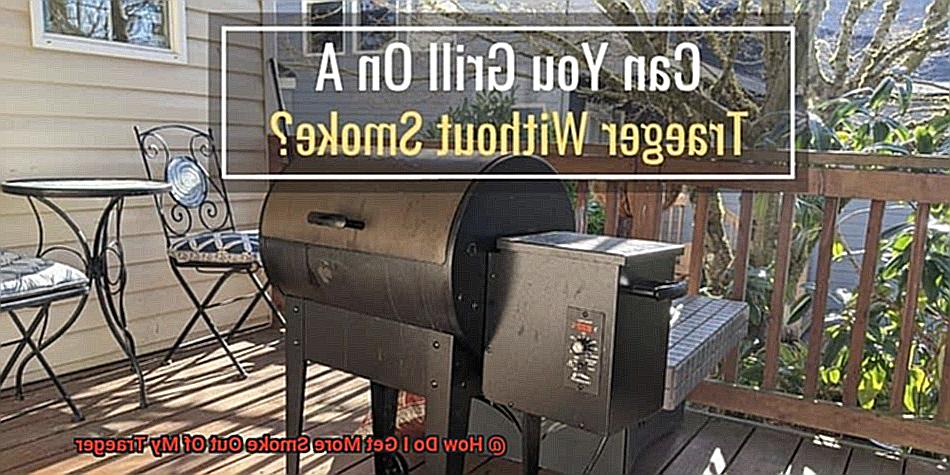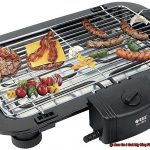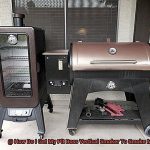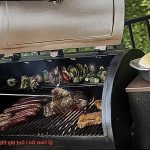Do you find yourself disappointed with the lack of smoky flavor in your meat from your Traeger smoker? Don’t worry, we’ve got your back. Today, we’re going to share some insider tips and tricks on how to get more smoke out of your Traeger.
Smoking meat is a true art form that requires patience and practice. Even experienced smokers can struggle to achieve that perfect smoky flavor with their Traeger grills. But fear not, because we’ve compiled all the best techniques to help you step up your game.
From selecting the right wood pellets to adjusting temperature settings, we’ll cover all the bases. We’ll even let you in on some top-secret methods like using a “Texas Crutch” or a smoke tube to maximize smoke production.
No matter which model of Traeger smoker you have – whether it’s a Pro, Ironwood, or Timberline – our tips will help you take your barbecue skills to new heights.
So put on your favorite apron and get ready for some serious smoking action. Let’s dive into our guide on how to get more smoke out of your Traeger.
Contents
Understanding the Different Types of Wood Pellets
When it comes to grilling, the type of wood pellet you use can make a significant difference in the flavor of your food. Traeger grills are known for their ability to infuse food with a smoky flavor, and the type of wood pellet you choose plays a vital role in achieving that flavor. In this article, we will discuss the different types of wood pellets available and how they affect the taste of food cooked on a Traeger grill.
Hickory Wood Pellets: Bold and Smoky Flavor for Beef and Pork
Hickory wood pellets are the go-to for grill masters who want a bold and smoky flavor in their beef and pork dishes. The strong flavor of hickory can overpower other flavors, so use sparingly to achieve the right balance. If you’re a fan of rich, bold flavors, hickory wood pellets are perfect for you.
Mesquite Wood Pellets: Intense Flavor for Chicken and Fish
Mesquite wood pellets offer an even more intense smoky flavor than hickory and work well with chicken and fish dishes. The robust and distinctive flavor of mesquite can add depth to your dishes but should also be used sparingly to avoid overpowering the natural flavors of the meat.
Apple and Cherry Wood Pellets: Sweet and Fruity Flavors for Pork, Poultry, and Seafood
For those who prefer sweet and fruity flavors in their meat, apple and cherry wood pellets are ideal. These pellets complement pork, poultry, and seafood dishes perfectly. The sweet and fruity flavor adds a touch of elegance to the natural taste of meat without being overwhelming. Apple and cherry wood pellets are also great for smoking cheese and vegetables.
Pecan Wood Pellets: Subtle Nutty Flavors for Poultry, Pork, and Beef
Pecan wood pellets offer a milder smoky flavor than hickory, but still provide a subtle, nutty taste that pairs well with poultry, pork, and beef. For those who prefer a slightly milder taste, pecan wood pellets are a great option. They offer a delicate flavor that complements the natural flavors of meat without overpowering them.
Choosing the Right Wood Pellets for Your Traeger Grill
Not all wood pellets are created equal. Some brands may use fillers or additives that can affect the flavor of your food. Look for high-quality brands that use 100% natural wood with no additives or fillers.
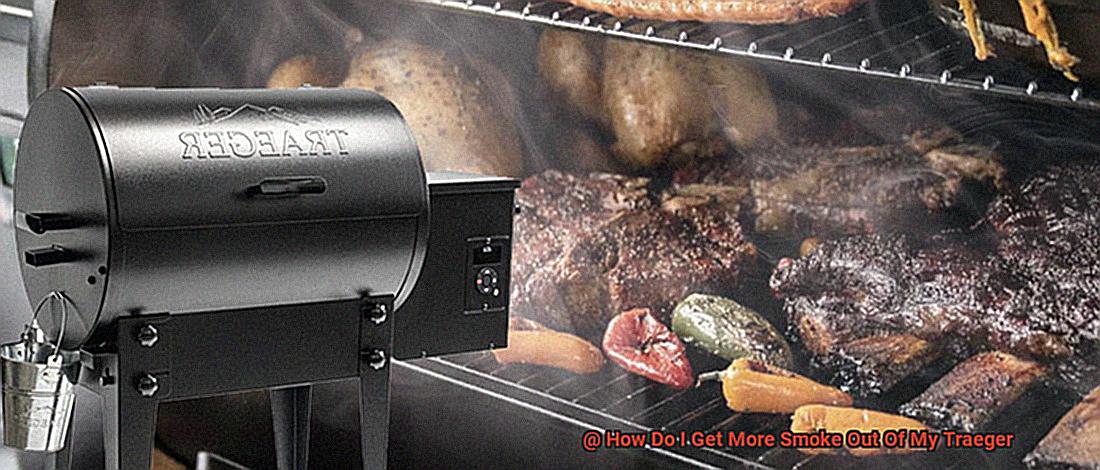
Experimenting with different wood pellet combinations can help you find the perfect balance of smoke and flavor for your Traeger grill. Remember to set the temperature to a lower setting to produce more smoke and add a smoker box filled with wood chips to increase smoke production.
Lowering the Temperature for Maximum Smoke Production
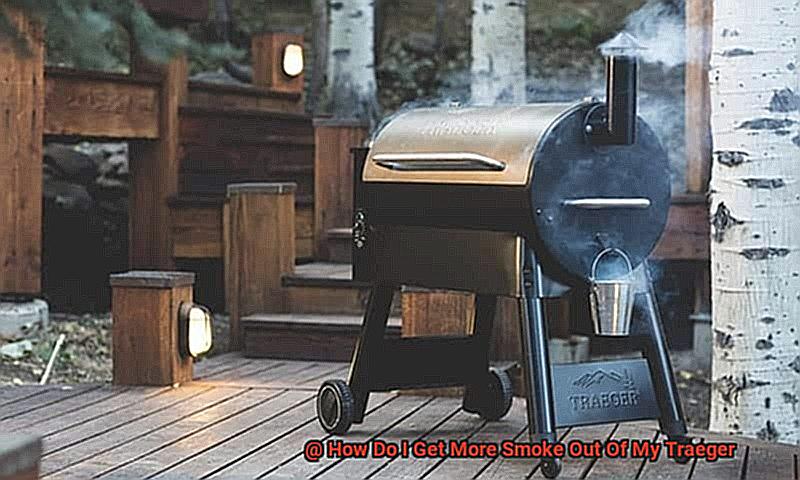
Fear not, because we have a tried and true method to take your Traeger smoking game to the next level – lowering the temperature.
When smoking meat, the goal is to infuse it with a savory smoky flavor that penetrates deep into the meat. By lowering the temperature of your grill, you extend the cooking time, allowing more time for the smoke to interact with the meat and achieve that desired smoky flavor.
But that’s not all – reducing the temperature also decreases the risk of overcooking your meat. Cooking at high temperatures can quickly dry out your meat, resulting in an unpleasant texture and flavor. Lowering the temperature ensures that your meat remains juicy and tender while still absorbing that sought-after smoky taste.
So what’s the sweet spot temperature for smoking? We suggest maintaining your Traeger between 180-225°F for maximum smoke production. This range guarantees a generous amount of smoke while ensuring perfectly cooked and flavorful meat.
Moreover, taking your time to smoke meat is critical. Smoking is a slow cooking process, and it may take hours to achieve optimal results. Patience is key here, but trust us, the payoff is worth it when you savor that first bite of scrumptious smoked meat.
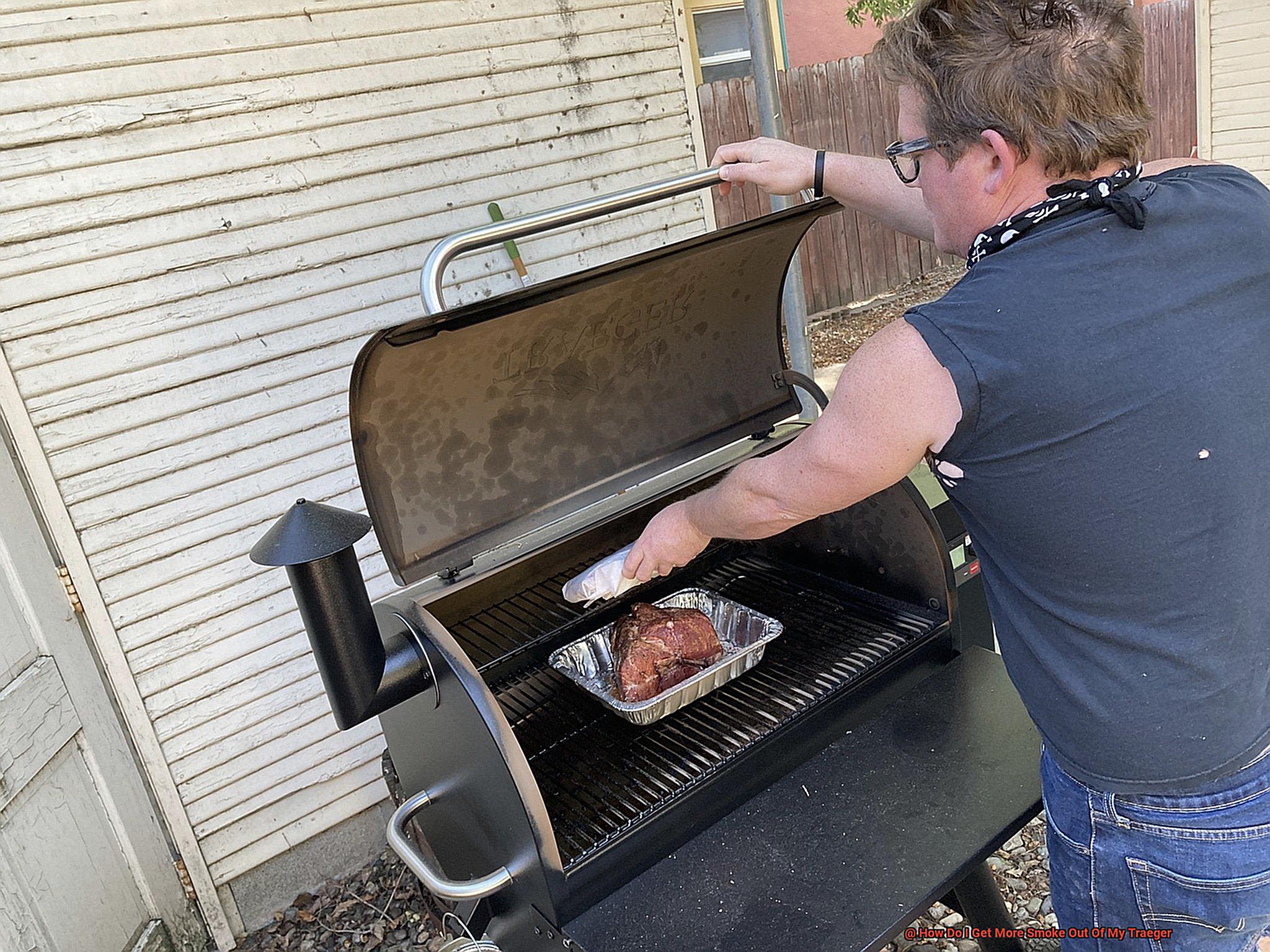
Adding a Smoker Box to Your Grill
Look no further than a smoker box. This small metal container is filled with wood chips or pellets and placed directly on the grill grates. As the heat from your grill causes the wood chips to smolder, they release smoke and infuse your food with mouth-watering smokiness.
To maximize the flavor potential of your smoker box, follow these steps:
Step 1: Select the Right Wood Chips
Different woods produce different flavors, so choose wood chips that complement the food you’re grilling. For instance, hickory and mesquite are perfect for beef and pork, while apple and cherry are ideal for poultry and fish.
Step 2: Soak Your Wood Chips
Soaking your wood chips in water for at least 30 minutes before use will slow down their burning rate and lead to more flavorful smoke. For an added twist, try soaking them in beer, wine, or other liquids to deepen the flavor profile.
Step 3: Fill Your Smoker Box
Fill your smoker box with the soaked wood chips, then place it directly on top of the grill grates. Be sure there’s enough space around it for air to circulate.
Step 4: Adjust Your Cooking Time and Temperature
Keep in mind that adding a smoker box may impact the temperature inside your Traeger grill. The smoker box occupies space on the grill grates, which reduces direct heat to your food. You may need to adjust your cooking time accordingly or use a higher temperature setting to compensate.
Step 5: Savor Your Smoky Creations.
With these simple steps, you can transform everyday dishes into smoky delights that will leave your guests asking for more. Whether you’re smoking meats, veggies, or even desserts, remember that patience is key when it comes to smoking. The longer you smoke your food, the more intense the flavor will be.
Leaving the Lid Open for the First 5-10 Minutes of Cooking
This method is all about maximizing your grill’s smoke production, resulting in a more flavorful meal.
By leaving the lid open for a short period, you allow the initial flames and smoke to develop and accumulate in the cooking chamber before closing the lid to trap them inside. This means your food gets more time to soak up all that delicious smokiness, resulting in a mouth-watering aroma and flavor that will have your taste buds dancing with joy.
But it’s not just about flavor. Leaving the lid open can also help prevent flare-ups caused by excess grease or oil in the cooking chamber. This ensures that your food cooks evenly and prevents any unwanted charring or burning.
It’s important to note that this technique should only be used for a short period because leaving the lid open for too long can cause temperature fluctuations that can negatively impact your food’s quality. Therefore, experts recommend leaving the lid open for no longer than 10 minutes before closing it to maintain a consistent temperature.
To get the most out of this technique, it’s crucial to keep a close eye on your food and grill temperature. You want to maintain a consistent temperature while also infusing your food with as much smoky goodness as possible. It may take some trial and error, but with practice, you’ll find the perfect balance between smoke flavor and temperature control.
In addition to leaving the lid open, consider using a smoker box filled with wood chips soaked in beer or wine for added depth of flavor. Just remember to adjust your cooking time and temperature accordingly.
Investing in a Cold Smoker Attachment
Before you rush out to buy one, there are some key considerations to keep in mind.
First and foremost, make sure that the attachment you choose is compatible with your Traeger grill model. Don’t let the excitement of a new attachment be dampened by disappointment when it doesn’t fit your grill. Secondly, consider the size of the attachment and ensure that it will comfortably fit onto your grill. Choosing an attachment that’s too small or too large can affect the quality of the smoke.
Another important factor is the type of wood chips or pellets you want to use with your cold smoker attachment. The type of wood you use can significantly impact the flavor of your food. Popular choices include hickory, mesquite, applewood, and cherrywood. Experimenting with different types can help you find your favorite.
When it comes to choosing a cold smoker attachment, there are plenty of options available on the market. One popular choice is the Smoke Daddy Cold Smoke Generator, which uses a small electric fan to circulate smoke through the grill and can be used with any type of grill or smoker, including Traeger grills. Another great option specifically designed for Traeger grills is the A-MAZE-N pellet smoker, which produces a slow and steady stream of smoke for up to 12 hours and is easy to use and clean.
It’s worth noting that investing in a cold smoker attachment may require an additional expense. However, if you’re someone who takes their smoking seriously, it’s a worthwhile investment that can help unlock the full potential of your Traeger grill. With the right attachment and wood chips or pellets, you can create mouth-watering dishes that are sure to impress your family and friends.
Tips on Choosing the Right Type of Wood Pellets
When it comes to grilling, the flavor is everything. And the type of wood pellets you choose for your Traeger grill can make or break your dishes. Here are five factors to consider when choosing the right type of wood pellets for your Traeger grill.
Types of Wood Pellets
Different types of wood pellets will produce different levels of smoke and flavor. Hickory and mesquite are known for producing a strong smoke flavor, while apple and cherry impart a sweeter, more mild taste. Oak is a versatile option that pairs well with most meats and dishes. Choose the wood pellet that complements your flavors.
Quality of Wood Pellets
The quality of the wood pellets you use is crucial to the taste and performance of your Traeger grill. Look for pellets made from 100% hardwood, with no fillers or additives. Lower quality pellets may produce less smoke and flavor and even damage your grill in the long run.
Size and Shape of Wood Pellets
Traeger grills are designed to work best with pellets that are roughly the size of a pencil eraser. Using larger or irregularly-shaped pellets may lead to inefficient burning, affecting the overall flavor of your dishes. Use the recommended size to ensure consistent burning and optimal results.
Moisture Content of Wood Pellets
The moisture content of your wood pellets can also affect the smoke and flavor of your dishes. Too dry pellets can burn too quickly and produce less smoke, while too moist pellets may not burn at all. Look for pellets with a moisture content around 6-8% for optimal results.
Experiment with Different Types
Don’t be afraid to experiment with different types of wood pellets to find the one that best suits your taste preferences. Try mixing different types of woods to create unique flavor profiles and enhance your grilling experience.
Understanding How Temperature Affects Smoke Production
As any grill master knows, smoke is the key to unlocking the full flavor potential of your grilled meats and veggies. And when it comes to using a Traeger grill, understanding how temperature affects smoke production is crucial. Here’s why:
Smoke is created when wood pellets are burned, producing flavorful vapors that infuse your food with a delicious, smoky taste. However, the amount of smoke produced is directly related to the temperature at which the wood pellets burn.
Lower Temperature = More Smoke
At lower temperatures, less smoke is produced because the wood pellets burn more slowly and less hotly. This means that if you want to increase the amount of smoke your Traeger produces, you’ll need to lower the temperature of your grill. You can accomplish this by adjusting the settings on your Traeger controller or by using a separate temperature control device.
Higher Temperature = Less Smoke
On the flip side, if you want less smoke, you’ll need to increase the temperature of your grill. This will cause the wood pellets to burn more quickly and produce less smoke overall. Keep in mind that while increasing the temperature may reduce smoke production, it can also lead to a drier, less flavorful result in your food.
Other Factors That Affect Smoke Production
Temperature isn’t the only factor that affects smoke production. The type of wood pellets you use and the amount of airflow in your grill can also make a difference. Experimenting with different types of wood pellets and adjusting airflow can help you achieve the perfect level of smokiness in your food.
Choose The Right Wood Pellets
Choosing the right wood pellets is key to unlocking that perfect smoky flavor. Consider factors such as type (hickory, mesquite, applewood, etc.), quality, size and shape, and moisture content when selecting your wood pellets.
mQ7Z9JIuqiM” >
Conclusion
In conclusion, mastering the art of getting more smoke out of your Traeger grill takes a combination of technique, experimentation, and understanding the factors that influence smoke production. To achieve that perfect smoky flavor, it’s essential to start with high-quality wood pellets made from 100% natural hardwood with no additives or fillers.
But don’t stop there – try experimenting with different wood pellet combinations to find the ideal balance of smoke and flavor for your Traeger grill. And when it comes to temperature settings, lowering the heat to between 180-225°F is key for maximum smoke production.
For an extra boost in flavor potential, consider adding a smoker box filled with wood chips soaked in beer or wine. And if you’re looking to take things up a notch, investing in a cold smoker attachment can help you achieve even more intense smoky flavors.
Don’t forget about the impact of temperature on smoke production – understanding how temperature affects your grill will help you achieve optimal results. And lastly, leaving the lid open for the first few minutes of cooking can also help maximize smoke production.
By following these insider tips and tricks, you’ll be well on your way to becoming a true Traeger grill master.

